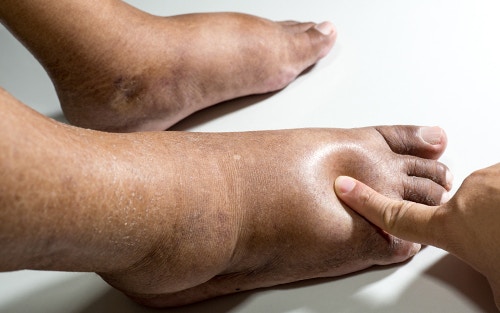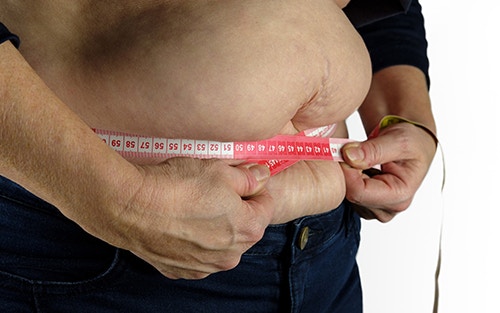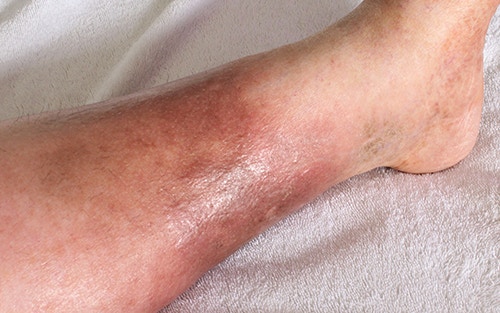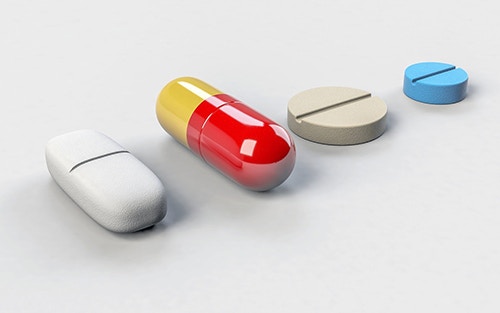Keep your swollen feet from leaving you in pain, immobilized, and scared. Knowing what causes your feet to swell and how to treat your feet will help you get things back to normal quickly.

yourfootpalace.com gathered the following information about what causes your feet to swell, which treatments may work for you, what you can do to prevent this type of swelling, and when to seek medical help.
Swollen Feet Causes, Treatment, and Prevention
Also known as peripheral edema, this swelling of the foot, leg, or ankle on the left, right, or both sides happens when fluid accumulates in these body parts. Unless swelling occurs or is due to injury, this fluid accumulation isn’t usually painful. Consider the following potential reasons for your swelling:
Swollen Feet from Injuries

Some injuries may cause your foot, ankle, and lower leg(s) to swell. These injuries can occur from:
- Slips
- Falls
- Overly strenuous exercise
- Sports-related impacts
- Vehicular accidents
Such injuries can take an extended amount of time to heal, depending on their severity, especially when accompanied by a fracture(s).
Injury Treatment
Keep in mind that the muscles, ligaments, and bones comprising the feet are significantly stronger than those in other areas of the body. When an injury and subsequent swelling occur, it will likely require extended periods of immobility and care to fully return to normal. The following R.I.C.E. method should help:
Rest – Rest your ankle as much as possible.
Ice – Apply ice packs or submerge your foot and ankle in cold water.
Compression – Use an elastic ankle sleeve or an elasticized wrap to help reduce swelling.
Elevation – Elevate your ankle to the height of your hip when in a seated position.
Recovering from injuries affecting the feet should be accompanied by your primary care physician. In some cases, medication may be prescribed to manage either pain, or swelling, or both.
Watch this video about using the RICE method.
Foot Injury Prevention
Here are some simple tips to help you avoid foot injuries:
- Warm-up before any exercise, sports, or strenuous activity.
- Condition your muscles for the activity or sport.
- Choose athletic or appropriate shoes that properly support your foot type.
- Replace shoes when the tread or heels wear down.
- Avoid running or stepping on uneven surfaces.
Tip: Frequent foot massages will help keep your feet and ankles relaxed and limber.
Swollen Feet Caused by Overweight/Obesity

Carrying too much or elevated body mass can significantly decrease your blood circulation, causing fluid to build up in the feet, legs, and ankles.
Overweight/Obesity Treatment
One of the first steps to treating your elevated weight or obesity is to make yourself fully aware of how much extra weight you are carrying and how it affects your health. Read our blog and find out how to measure your hip to waist ratio and the Side Effects of Being Overweight.
Overweight/Obesity Prevention
Behavior changes will ultimately determine your weight loss and stability – Ideally, developing lifestyle habits that promote maintaining a healthy weight range. Short-term “diets” that you “hop on” and then “fall off” are not the answer to long-term or successful weight management. These behaviors include:
- Weighing yourself regularly
- Making time for regular physical activity
- Eating meals at regular times, including breakfast
- Reducing calorie and fat consumption
- Focusing on nutritional value vs. craving satisfaction
- Rewarding yourself when accomplishing milestones
- Not allowing small “slips” to develop into significant weight regain
Whatever activities or incentives you use to encourage yourself through your weight loss journey should include elements contributing to your health and wellness.
Swollen Feet from Standing and Sitting

Standing or sitting for long periods may lead to swelling. Inactive muscles have significant difficulties pumping body fluids back up to the heart. Retention of water and blood can cause swelling in the lower legs and feet.
Standing and Sitting Swelling Treatment
We often find ourselves sitting or standing for extended periods at work, while operating a vehicle, or other activity that limits our mobility. Use the following to avoid over-stressing the heart and maintain blood flow:
- Take frequent breaks
- Shift position or move locations in 20 to 30-minute intervals
- Avoid positions that cause your lower legs and feet any discomfort or hypersensitivity
- Utilize cushions or supports that relieve stress to your lower legs and feet
- If possible, keep your feet elevated at or near waist-level
Tip: Be patient when trying to find better sitting and standing positions. It can take some time and experimentation to determine what to modify.
Standing and Sitting Swelling Prevention
This type of swelling can usually be prevented by maintaining both good sitting and standing posture. Your old posture habits may be hard to break, and when you are trying to improve your posture, your own muscles will likely work against you initially.
Find more information on good posture at yourfootpalace.com/how-to-make-good-posture-habit/
Swollen Feet Caused by Blood Clots
A blood clot is a clump of blood formed into a solid-state. When a blood clot forms in the leg, it can severely impair blood flow, leading to swelling in the feet and discomfort.
Blood Clot Treatment
Depending on where blood clots form will determine how they will be treated. When they form in the leg’s veins and present an extreme danger to your health, drugs called thrombolytics that dissolve blood clots may be used in conjunction with:
- Heparin injections
- Warfarin medication
Note: All cases of swelling that result from blood clots or Deep Vein Thrombosis (DVT) should be closely monitored by your primary care physician.
Watch this video for more on blood clots.
Blood Clot Prevention
If you have a history of developing blood clots or have a heightened risk of developing them, your doctor may prescribe the following preventive measures:
- Increase water consumption
- Wear loose-fitting clothes, socks, or stockings
- Raise your legs 6 inches above your heart from time to time
- Wear compression stockings if your doctor prescribes them
- Do the exercises your doctor recommends
- Change your position often, especially during a long trip
- Do not stand or sit for more than 1 hour at a time
- Eat less salt
- Try not to bump or hurt your legs and try not to cross them
- Do not use pillows under your knees
- Take all medicines the doctor prescribes you
Tip: Elevate the bottom (foot) of your bed 4 to 6 inches with blocks or books.
Note: Blood thinners/Anticoagulants can cause side effects. Bleeding is the most common issue. Your doctor will observe you closely. If you notice something wrong that you think may be caused by your medication, call your doctor.
Swollen Feet from Lymphedema
This condition is also known as lymphatic obstruction. Lymphedema causes blockages in the lymphatic system, made up of lymph nodes and blood vessels that help carry fluid throughout the body. A blockage in the lymphatic system causes tissue swelling and results in swelling of the arms and legs.
Lymphedema Treatment
You can be born with this condition (primary lymphedema) or develop it from damage to the lymphatic system, such as after surgery, other treatments, or infection (secondary lymphedema).
- Early-stage lymphedema can be treated non surgically, including medication, a healthy diet, and manual compression.
- For advanced stages of lymphedema, surgical intervention may be recommended.
Watch this video to see how a lymphatic self massage is done.
Lymphedema Prevention
For those who have had surgery to remove lymph nodes, activities that put too much pressure on the affected arm should be avoided. Protective measures to prevent injury and infection should include:
- Maintaining proper hygiene
- Staying physically fit
- Avoiding cuts
- Wearing unrestrictive/protective clothing
- Notify your doctor of any abnormalities
As previously mentioned, lymphedema can be treated more effectively in its early stages.
Note: Stage 1 lymphedema is not accompanied by noticeable signs or symptoms. Stage 2 lymphedema may present swelling that resolves with elevation. Stages 3 and 4 present permanent swelling, significant changes in skin thickness, and the development of scarring.
Swollen Feet Resulting from Venous Insufficiency

This condition occurs when veins can no longer adequately pump blood, causing blood to pool in the legs.
Venous Insufficiency Treatment
A common treatment for venous insufficiency includes prescription compression stockings. These stockings apply pressure at the ankle and lower leg level. They help improve blood flow and can significantly reduce leg swelling. Compression stockings are available in a range of prescription strengths and different lengths.
Venous Insufficiency prevention
Preventive measures you can adopt immediately without a doctor’s prescription include:
- Avoid sitting or standing in one position for long periods. Get up and move around frequently.
- Don’t smoke (if you do smoke, quit)
- Get regular exercise (consult your doctor if you have any conditions that may be exacerbated by an exercise routine)
- Maintain healthy body weight.
Tip: As there is no cure for venous insufficiency, prevention is of utmost importance.
Swollen Feet Caused by Heart Disease
Swollen feet could be a sign of heart disease or pending heart failure. If the heart is damaged, it cannot pump blood to and from the heart efficiently. Right-sided heart failure can cause the body to retain salt and water, resulting in swollen feet.
Heart Disease Treatment
Treatments for this condition vary widely and may include everything from lifestyle changes to medications, surgery, stents, pacemakers, and ablation.
Watch this video about how heart failure is diagnosed.
Heart Disease Prevention
While heart disease has a hereditary aspect, here is what you can do to significantly reduce your risk:
- Control your blood pressure
- Maintain a healthy body weight
- Eat a healthy diet
- Control your cholesterol and triglyceride levels
- Exercise regularly
- Limit alcohol consumption
- Don’t smoke
- Manage/reduce stress levels
- Control your diabetes
- Maintain good sleep habits
According to MedlinePlus.gov heart disease is the leading cause of death in the United States. Some of the risk factors you cannot change include your age, sex, race, and family history.
Swollen Feet from Pericarditis
This health affliction is a long-term inflammation of the pericardium (the sac-like membrane around the heart). The condition causes breathing difficulties and severe, chronic swelling in the legs and ankles.
Pericarditis Treatment
You may be prescribed medication to reduce inflammation and swelling like:
- Pain relievers – Pericarditis pain can usually be treated with over-the-counter pain relievers, like aspirin or ibuprofen. In more severe cases, prescription-strength pain relievers may be used.
- Colchicine (Colcrys, Mitigare). This drug reduces inflammation in the body and is used to treat acute pericarditis or if your symptoms tend to repeat. You should not take this drug if you have liver or kidney disease. Your doctor should carefully evaluate whether you take this drug or not.
- Corticosteroids. These are strong medications that fight inflammation. Your doctor may recommend and prescribe a corticosteroid like prednisone if your symptoms don’t improve with other medications or if symptoms keep returning.
Note: When pericarditis is caused by a bacterial infection, treatments will likely include antibiotics and drainage.
Drainage and surgery options include:
- Pericardiocentesis. In this procedure, a sterile needle or a small tube (catheter) is used to remove and drain excess fluid from the pericardial cavity. This drain stays in place for several days while you are in the hospital.
- Pericardiectomy. This surgery removes the entire pericardium. This procedure may be necessary if the sac surrounding your heart has become permanently rigid due to constrictive pericarditis.
Pericarditis Prevention
According to the American Heart Association, acute pericarditis can’t be prevented. However, You and your doctor can take steps to lower your chance of having a repeat acute episode, complications, or chronic pericarditis. These steps include getting prompt and accurate treatment, following your prescribed treatment plan, and seeking ongoing medical care as needed.
Watch this video about pericarditis.
Swollen Feet Caused by Cirrhosis (Liver Disease)
This refers to severe liver scarring, often caused by chronic alcohol abuse or hepatitis B or C infection. The condition can cause high blood pressure and poor circulation in the feet, legs, and ankles.
Cirrhosis Treatment
There is no current cure for cirrhosis. Doctors will focus on halting damage to your liver and prevent complications. In advanced cases of this disease, when the liver ceases to function, a partial or total liver transplant may be the only viable treatment option.
Cirrhosis Prevention
Vaccination is available for Hepatitis A and B. Screening for Hepatitis C is recommended in some regions/populations.
Other ways to prevent liver cirrhosis include:
- Don’t abuse alcohol. If you drink alcohol, restrict how much and how often
- Eat a well-balanced, low-fat diet, like the Mediterranean diet
- Avoid consuming raw seafood, including oysters and clams
- Reduce the amount of salt in your diet
If you are at risk for liver disease, seek preventive care that protects you from infection and irreversible damage.
Watch this video to see how liver problems manifest in the feet.
Swollen Feet from Kidney Disease
People with poor kidney function might have significant difficulties evacuating fluid from the body, which can build up. Kidney disease may remain asymptomatic until the condition is severe and the kidneys are already in decline and beginning to fail. Signs and symptoms of kidney failure may include:
- Less frequent/difficulty urinating
- Shortness of breath
- Drowsiness or fatigue
- Swelling in legs and feet
- Pressure in the chest
- Seizures
- Nausea
- Confusion
- Coma
Any one or a combination of these symptoms should prompt you to seek medical attention or an evaluation for kidney disease.
Watch this video for more on symptoms of kidney disease.
Kidney Disease Treatment
In the early stages of kidney disease, medications can help manage symptoms. However, in later stages, dialysis (filtering the blood with a machine) or a kidney transplant may be needed.
Kidney Disease Prevention
The most effective kidney disease preventive measures include living a healthier lifestyle by eating a more balanced diet, remaining active, controlling your blood pressure, and not smoking.
Other Conditions Causing Swollen Feet
Preeclampsia – This condition causes high blood pressure during pregnancy. The increase in blood pressure can result in poor circulation and swelling in the face, hands, legs, and feet.
Natural Hormonal Changes – Fluctuating estrogen and progesterone levels may cause reduced circulation in the legs, resulting in swelling. These changes in hormone levels may occur during pregnancy and a woman’s menstrual cycle.
Reactions To Medication – Foot, leg, and ankle swelling can also occur while taking particular medications, like:

- Steroids
- Estrogen
- Testosterone
- Antidepressants – including tricyclics and monoamine oxidase inhibitors (MAOIs)
- Nonsteroidal Anti-Inflammatory Drugs (NSAIDs), including ibuprofen and aspirin
Tip: These types of medications can lead to water retention, resulting in mild to severe leg, foot, and ankle swelling.
When To Seek Medical Help
While swelling in the foot, leg, and ankle usually doesn’t pose a significant health risk, it’s important to know when you should see a doctor. Swelling may sometimes indicate a developing or grave underlying health issue that should be treated immediately.
Report your symptoms and condition to your doctor if your swelling leaves an indentation if you press your finger into it, if it has developed suddenly, lasts for more than 48 hours, affects only one foot, or is accompanied by pain or skin discoloration.
Swollen Feet
In this article, you discovered many of the reasons your feet may swell up, appropriate treatments, how to prevent this swelling, and when to seek medical attention.
Knowing what to do when your feet swell up will help you identify and mitigate what is causing the swelling to occur.
Refusal to address underlying causes of lower leg and foot swelling may result in costly and catastrophic health crises, extended hospital stays, and potentially crippling conditions.
Sources:
mayoclinic.org/diseases-conditions/edema/symptoms-causes/syc-20366493
health.harvard.edu/diseases-and-conditions/whats-causing-those-swollen-feet
health.clevelandclinic.org/6-best-ways-relieve-swollen-feet-ankles-home/
rush.edu/news/feet-and-your-health
ahrq.gov/patients-consumers/prevention/disease/bloodclots.html
hopkinsmedicine.org/health/treatment-tests-and-therapies/treating-lymphedema
heart.org/en/health-topics/pericarditis/prevention-and-treatment-of-pericarditis
(706) 521-5290
(678) 963-5958